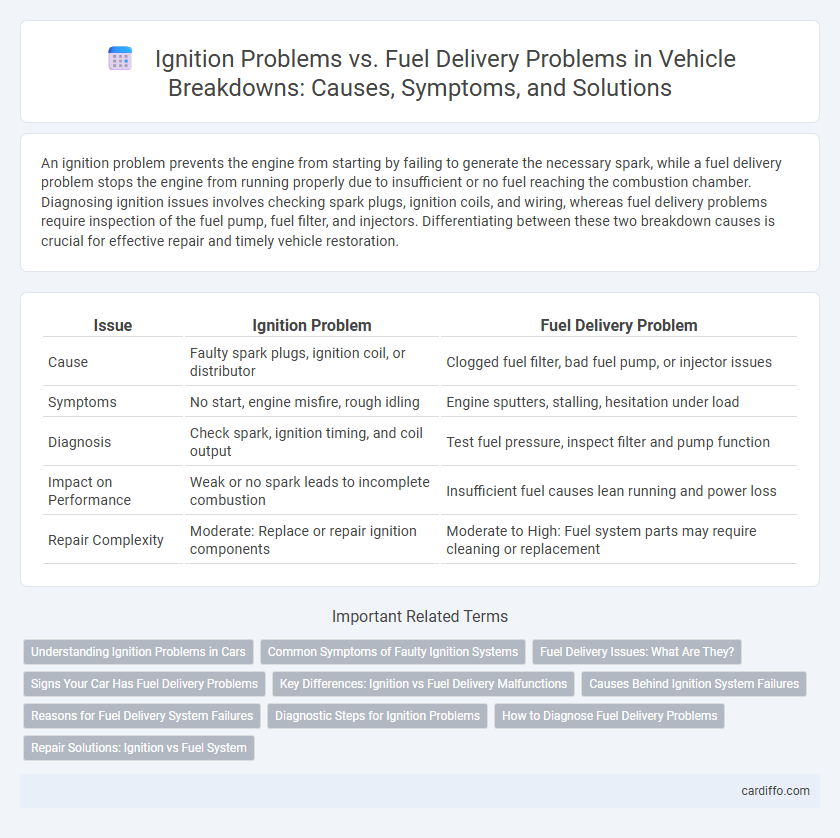An ignition problem prevents the engine from starting by failing to generate the necessary spark, while a fuel delivery problem stops the engine from running properly due to insufficient or no fuel reaching the combustion chamber. Diagnosing ignition issues involves checking spark plugs, ignition coils, and wiring, whereas fuel delivery problems require inspection of the fuel pump, fuel filter, and injectors. Differentiating between these two breakdown causes is crucial for effective repair and timely vehicle restoration.
Table of Comparison
| Issue | Ignition Problem | Fuel Delivery Problem |
|---|---|---|
| Cause | Faulty spark plugs, ignition coil, or distributor | Clogged fuel filter, bad fuel pump, or injector issues |
| Symptoms | No start, engine misfire, rough idling | Engine sputters, stalling, hesitation under load |
| Diagnosis | Check spark, ignition timing, and coil output | Test fuel pressure, inspect filter and pump function |
| Impact on Performance | Weak or no spark leads to incomplete combustion | Insufficient fuel causes lean running and power loss |
| Repair Complexity | Moderate: Replace or repair ignition components | Moderate to High: Fuel system parts may require cleaning or replacement |
Understanding Ignition Problems in Cars
Ignition problems in cars often manifest as difficulty starting the engine, misfires, or stalling caused by faulty spark plugs, ignition coils, or the ignition switch. Unlike fuel delivery issues that typically result in fuel starvation or poor engine performance due to clogged fuel filters or a failing fuel pump, ignition problems directly disrupt the spark necessary for combustion. Diagnosing ignition faults requires testing electrical components and wiring to ensure proper spark generation and timing.
Common Symptoms of Faulty Ignition Systems
Common symptoms of faulty ignition systems include engine misfires, difficulty starting the engine, and poor fuel efficiency. These issues often result from worn spark plugs, damaged ignition coils, or faulty ignition control modules. Unlike fuel delivery problems that cause fuel starvation or flooding, ignition faults specifically disrupt the spark generation necessary for combustion.
Fuel Delivery Issues: What Are They?
Fuel delivery issues occur when the engine does not receive the proper amount of fuel needed for combustion, often caused by clogged fuel filters, failing fuel pumps, or dirty fuel injectors. These problems result in poor engine performance, difficulty starting, and stalling, as the air-fuel mixture becomes too lean or inconsistent. Diagnosing fuel delivery faults involves checking fuel pressure, fuel pump operation, and injector function to ensure adequate fuel flow to the engine.
Signs Your Car Has Fuel Delivery Problems
Signs your car has fuel delivery problems include difficulty starting the engine, engine sputtering at high speeds, and sudden loss of power during acceleration. A noticeable drop in fuel efficiency and frequent stalling, especially when idling, can also indicate clogged fuel filters or a failing fuel pump. Check for unusual noises from the fuel tank area and irregular fuel pressure readings to diagnose potential fuel delivery issues accurately.
Key Differences: Ignition vs Fuel Delivery Malfunctions
Ignition problems typically involve issues with spark plugs, ignition coils, or the ignition control module that prevent the engine from firing properly, resulting in misfires or failure to start. Fuel delivery malfunctions relate to the fuel pump, fuel filter, or injectors, causing insufficient or irregular fuel flow to the combustion chamber, leading to engine sputtering, hesitation, or stall. Key differences lie in the source of failure: ignition problems affect the electrical spark system, while fuel delivery problems concern the physical supply of fuel.
Causes Behind Ignition System Failures
Common causes behind ignition system failures include faulty spark plugs, defective ignition coils, and malfunctioning ignition control modules, which disrupt the spark needed for combustion. Electrical issues such as corroded wiring, weak battery voltage, or a failing crankshaft position sensor can also prevent proper ignition timing. These ignition problems differ from fuel delivery issues, which typically involve clogged fuel filters, failing fuel pumps, or injector malfunctions that impair fuel flow rather than spark generation.
Reasons for Fuel Delivery System Failures
Fuel delivery system failures often result from clogged fuel filters, deteriorated fuel pumps, or contaminated fuel lines that restrict proper fuel flow to the engine. Sediment buildup, corrosion, and vapor lock are common causes disrupting consistent fuel pressure essential for engine operation. Detecting these issues is crucial for differentiating fuel delivery problems from ignition system failures, which affect spark generation rather than fuel supply.
Diagnostic Steps for Ignition Problems
Diagnosing ignition problems begins with inspecting the ignition coil and spark plugs for wear or damage that could cause weak or absent sparks. Testing for proper voltage at the ignition coil and verifying the functionality of the ignition control module helps pinpoint electrical issues. Checking the distributor cap, rotor, and ignition timing ensures mechanical components are functioning correctly to provide consistent spark delivery.
How to Diagnose Fuel Delivery Problems
Diagnosing fuel delivery problems involves checking for symptoms such as engine sputtering, stalling, or difficulty starting despite a strong ignition spark. Inspect the fuel pump operation, fuel filter condition, and fuel pressure using a gauge to ensure consistent fuel flow to the engine. Confirming these elements helps distinguish fuel delivery issues from ignition faults, guiding effective troubleshooting steps.
Repair Solutions: Ignition vs Fuel System
Ignition problems often stem from faulty spark plugs, ignition coils, or wiring issues, requiring targeted repairs like spark plug replacement or coil testing to restore engine performance. Fuel delivery problems typically involve clogged fuel filters, failing fuel pumps, or injector malfunctions, necessitating fuel system cleaning, pump replacement, or injector servicing for optimal fuel flow. Diagnosing the root cause accurately ensures the repair solution--ignition repair or fuel system maintenance--effectively resolves the breakdown and prevents recurrent engine starting issues.
Ignition problem vs fuel delivery problem Infographic

 cardiffo.com
cardiffo.com